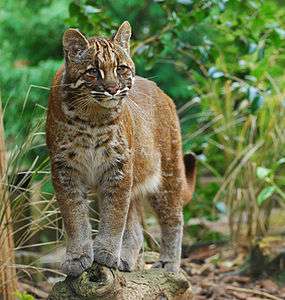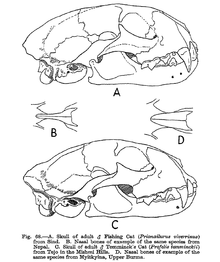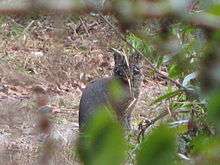Asian golden cat
| Asian golden cat | |
|---|---|
 | |
| Scientific classification | |
| Kingdom: | Animalia |
| Phylum: | Chordata |
| Class: | Mammalia |
| Order: | Carnivora |
| Suborder: | Feliformia |
| Family: | Felidae |
| Subfamily: | Felinae |
| Genus: | Catopuma |
| Species: | C. temminckii |
| Binomial name | |
| Catopuma temminckii | |
 | |
| Distribution of the Asian golden cat | |
| Synonyms | |
|
Pardofelis temminckii | |
The Asian golden cat (Catopuma temminckii, syn. Pardofelis temminckii), also called the Asiatic golden cat and Temminck's cat, is a medium-sized wild cat of the northeastern Indian subcontinent and Southeast Asia. It has been listed as Near Threatened on the IUCN Red List since 2008, and is threatened by hunting pressure and habitat loss, since Southeast Asian forests are undergoing the world's fastest regional deforestation.[1]
The Asian golden cat was named in honor of the Dutch zoologist Coenraad Jacob Temminck, who first described the African golden cat in 1827.[2]
Characteristics

The Asian golden cat is heavily built, with a typical cat-like appearance. It has a head-body length of 66 to 105 cm (26 to 41 in), with a tail 40 to 57 cm (16 to 22 in) long, and is 56 cm (22 in) tall at the shoulder. The weight ranges from 9 to 16 kg (20 to 35 lb), which is about two or three times that of a domestic cat.[2]
The pelage is uniform in color, but highly variable, ranging from red to golden-brown, dark brown to pale cinnamon, and gray to black. Transitional forms among the different colorations also exist. It may be marked with spots and stripes. White and black lines run across the cheeks and up to the top of the head, while the ears are black with a central gray area.[2] Golden cats with leopard-like spots have been found in China, resembling large leopard cats. This spotted fur is a recessive characteristic.[4]
Distribution and habitat
The Asian golden cat ranges from eastern Nepal, northeastern India and Bhutan to Bangladesh, Myanmar, Thailand, Cambodia, Laos, Vietnam, southern China, Malaysia and Sumatra. It prefers forest habitats interspersed with rocky areas and inhabits dry deciduous, subtropical evergreen and tropical rainforests.[5]
Since Hodgson's description in 1831 of a male individual in Nepal under the binomial Felis moormensis, the country is believed to be the westernmost part of the cat's range.[6][7] However, no specimen has been recorded in the country, until in May 2009 a camera trap survey yielded the first photographic record of a melanistic Asian golden cat in Makalu Barun National Park at an altitude of 2,517 m (8,258 ft).[8] In the eastern Himalayas, Asian golden cats were recorded in temperate and subalpine forest in Sikkim's Khangchendzonga Biosphere Reserve up to 3,960 m (12,990 ft) altitude.[9] It also lives in more open terrain such as the grasslands of Assam's Manas National Park.[10] It has also been recorded in the Khasi hills of Meghalaya and in Dampa Tiger Reserve.[11][12] In Bhutan's Jigme Singye Wangchuck National Park, it was recorded by camera traps at an altitude of 3,738 m (12,264 ft).[13]
In northern Myanmar, it was recorded in Hkakaborazi National Park.[14] In 2015, it was recorded for the first time in the hill forests of Karen State.[15]
In Laos, it also inhabits bamboo regrowth, scrub and degraded forest from the Mekong plains to at least 1,100 m (3,600 ft).[16][17] Between 2004 and 2009, it was recorded in Chinese protected areas in the Qinling and Minshan Mountains.[18]
Results of surveys in Sumatra indicated that it is more common than sympatric small cats, suggesting that it is more numerous than previously believed.[19]
Ecology and behavior

Asian golden cats are territorial and solitary. Previous observations suggested that they are primarily nocturnal, but a field study on two radio-collared specimens revealed arrhythmic activity patterns dominated by crepuscular and diurnal activity peaks, with much less activity late at night. In the study, the male's territory was 47.7 km2 (18.4 sq mi) in size and increased by more than 15% during the rainy season. The female's territory was 32.6 km2 (12.6 sq mi) in size. Both cats traveled between only 55 m (180 ft) to more than 9 km (5.6 mi) in a day, and were more active in July than in March.[20]
Asian golden cats can climb trees when necessary. They hunt birds, hares, rodents, reptiles, and small ungulates such as muntjacs and young sambar deer.[5] They are capable of bringing down prey much larger than themselves, such as domestic water buffalo calves.[21] In the mountains of Sikkim Asian golden cats reportedly prey on ghoral.[22]
Captive Asian golden cats kill small prey with the nape bite typical of cats. They also pluck birds larger than pigeons before beginning to feed. Their vocalizations include hissing, spitting, meowing, purring, growling, and gurgling. Other methods of communication observed in captive Asian golden cats include scent marking, urine spraying, raking trees and logs with claws, and rubbing of the head against various objects – much like a domestic cat.[2]
Reproduction
Not much is known about the reproductive behavior of this rather elusive cat in the wild. Most of what is known has been learned from cats in captivity.[23] Female Asian golden cats are sexually mature between 18 and 24 months, while males mature at 24 months. Females come into estrus every 39 days, at which time they leave markings and seek contact with the male by adopting receptive postures.[24] During intercourse, the male will seize the skin of the neck of the female with his teeth. After a gestation period of 78 to 80 days, the female gives birth in a sheltered place to a litter of one to three kittens. The kittens weigh 220 to 250 g (7.8 to 8.8 oz) at birth, but triple in size over the first eight weeks of life. They are born already possessing the adult coat pattern and open their eyes after six to twelve days.[2] In captivity, they live for up to twenty years.[25]
A female Asian golden cat at the Washington Park Zoo (now the Oregon Zoo) showed a dramatic increase in the frequency of scent marking during estrus. At the same time, she often rubbed her neck and head on inanimate objects. She also repeatedly approached the male in the cage, rubbed on him, and adopted a receptive posture (lordosis) in front of him. The male's rate of scent marking increased during this time, as did his frequency of approaching and following the female. The male's mounting behavior included a nape bite, but in contrast to other small felids, the bite was not sustained.
A pair in the Washington Park Zoo produced 10 litters, each consisting of one kitten; two litters of a single kitten each were born at the Wassenaar Zoo in the Netherlands; and a single kitten was reported for another litter. Two litters of two kittens each were born at a private cat breeding facility in California, but neither litter survived.
Threats
Asian golden cats inhabit some of the fastest developing countries in the world, where they are increasingly threatened by habitat destruction following deforestation, along with a declining ungulate prey base.[1] Another serious threat is hunting for the illegal wildlife trade, which has the greatest potential to do maximum harm in minimal time.[5] It has been reported killed in revenge for depredating livestock, including poultry but also larger animals such as sheep, goats and buffalo calves.
Illegal wildlife trade
Asian golden cats are poached mainly for their fur.[26] In Myanmar, 111 body parts from at least 110 individuals were observed in four markets surveyed between 1991 and 2006. Numbers were significantly greater than those of non-threatened species. Among the observed skins was a specimen with ocelot-like rosettes — a rare tristis form. Three of the surveyed markets are situated on international borders with China and Thailand and cater to international buyers, although the Asian golden cat is completely protected under Myanmar's national legislation. Effective implementation and enforcement of CITES is considered inadequate.[27]
Conservation
Pardofelis temminckii is included in CITES Appendix I and fully protected over most of its range. Hunting is prohibited in Bangladesh, China, India, Indonesia, Malaysia, Myanmar, Nepal, Thailand and Vietnam. Hunting is regulated in Laos. No information about protection status is available from Cambodia.[5] In Bhutan, the felid is protected only within the boundaries of protected areas.[13]
The population size of the Asian golden cat is unknown and difficult to estimate. It was regarded as abundant in many countries until the later part of the last century, when poaching shifted away from tigers and leopards to this species. In China, it is reported to be the next rarest cat apart from tigers and leopards.
In captivity
As of December 2008, there were 20 Asian golden cats in eight European zoos participating in the European Endangered Species Programme. The pair in the German Wuppertal Zoo successfully bred in 2007, and in July 2008, two siblings were born and mother-reared. In 2008, a female kitten was also born in the French Parc des Félins. The species is also kept in the Singapore Zoo.[28] Apart from these, a few zoos in Southeast Asia and Australia also keep Asian golden cats.
Taxonomy
The Asian golden cat was first described by Nicholas Aylward Vigors and Thomas Horsfield in 1827.[29] Two subspecies are recognised as valid since 2017:[30]
- C. t. temminckii (Vigors and Horsfield, 1827) occurs in Sumatra and the Malay Peninsula
- C. t. moormensis (Hodgson, 1831) occurs from Nepal eastwards to Southeast Asia
Results of phylogeographic analysis indicates that the Asian golden cat, along with the bay cat and the marbled cat, diverged from the other felids about 9.4 million years ago, and that the Asian golden cat and bay cat diverged four million years ago. Because of the evident close relationship with the marbled cat, it has been suggested that all three species should be grouped in the genus Pardofelis.[31]
Mythology
In some regions of Thailand, the Asian golden cat is called Seua fai (Thai: เสือไฟ; "fire tiger"). According to a regional legend, the burning of an Asian golden cat's fur drives tigers away. Eating the flesh is believed to have the same effect. The Karen people believe that simply carrying a single hair of the cat is sufficient.[32] Many indigenous people believe the cat to be fierce, but in captivity it has been known to be docile and tranquil. In the south, it's called Kang kude (คางคูด). It's believed to be a fierce animal. It can hurt or eat the livestock of the villagers and can also hurt larger animals such as elephants.[33]
In China, the Asian golden cat is thought to be a kind of leopard and is known as "rock cat" or "yellow leopard". Different color phases have different names; those with black fur are called "inky leopards", and those with spotted coats are called "sesame leopards".[2]
References
- 1 2 3 McCarthy, J.; Dahal, S.; Dhendup, T.; Gray, T.N.E.; Mukherjee, S.; Rahman, H.; Riordan, P.; Boontua, N. & Wilcox, D. (2015). "Catopuma temminckii". The IUCN Red List of Threatened Species. IUCN. 2015: e.T4038A97165437. doi:10.2305/IUCN.UK.2015-4.RLTS.T4038A50651004.en. Retrieved 13 January 2018.
- 1 2 3 4 5 6 Sunquist, Mel; Sunquist, Fiona (2002). Wild cats of the World. Chicago: University of Chicago Press. pp. 52–56. ISBN 0-226-77999-8.
- ↑ Pocock, R.I. (1939). The Fauna of British India, including Ceylon and Burma. Mammalia. – Volume 1. Taylor and Francis, Ltd., London. Pp 259–264
- ↑ Allen, G.M. (1938). The mammals of China and Mongolia. New York: American Museum of Natural History.
- 1 2 3 4 Nowell, K.; Jackson, P. (1996). 'Wild Cats: status survey and conservation action plan. IUCN/SSC Cat Specialist Group, Gland, Switzerland.
- ↑ Hodgson, B. H. (1831). Some Account of a new Species of Felis. Gleanings in Science, Volume III. Calcutta 1832: 177–178.
- ↑ Ellerman J. R. and Morrison-Scott T. C. S. (1966). Checklist of Palaearctic and Indian mammals 1758 to 1946. London.
- ↑ Ghimirey, Y., Pal, P. (2009). First camera trap image of Asiatic golden cat in Nepal Archived 2011-07-26 at the Wayback Machine.. Cat News 51: 17.
- ↑ Bashir, T.; Bhattacharya, T.; Poudyal, K. & Sathyakumar, S. (2011). "Notable observations on the melanistic Asiatic Golden cat (Pardofelis temminckii) of Sikkim, India". NeBIO. 2 (1): 2–4.
- ↑ Choudhury, A. (2007). "Sighting of Asiatic golden cat in the grasslands of Assam's Manas National Park". Cat News. 47: 29.
- ↑ Nadig, S.; R., N.; Silva, A. P. (2016). "Small cats in the Himalayan foothills: the Asian Golden Cat of Nongkhyllem Wildlife Sanctuary, India" (PDF). Small Wild Cat Conservation News. 2: 23.
- ↑ Gouda, J.; Sethy, J. & Chauhan, N. P. S. (2016). "First photo capture of Asiatic golden cat in Dampa Tiger Reserve, Mizoram, India". Cat News. 64: 26–27.
- 1 2 Wang, S. W. (2007). A rare morph of the Asiatic golden cat in Bhutan's Jigme Singye Wangchuck National Park. Cat News 47: 27–28.
- ↑ Rao, M., Myint, T., Zaw, T., Htun, S. (2005). Hunting patterns in tropical forests adjoining the Hkakaborazi National Park, north Myanmar. Oryx 39(3): 292–300.
- ↑ Saw Sha Bwe Moo, Froese, G.Z.L., Gray, T. N.E. (2017). "First structured camera-trap surveys in Karen State, Myanmar, reveal high diversity of globally threatened mammals". Oryx: first view. doi:10.1017/S0030605316001113.
- ↑ Duckworth, J. W., Salter, R. E. and Khounboline, K. (compilers) (1999). Wildlife in Lao PDR: 1999 Status Report. Vientiane: IUCN – The World Conservation Union / Wildlife Conservation Society / Centre for Protected Areas and Watershed Management.
- ↑ Johnson, A., Vongkhamheng, C., Saithongdam, T. (2009). The diversity, status and conservation of small carnivores in a montane tropical forest in northern Laos. Oryx 43: 626–633 doi:10.1017/S0030605309990238
- ↑ Li, S., Wang, D., Lu, Z. & Mc Shea, W.J. (2010). "Cats living with pandas: The status of wild felids within giant panda range, China". Cat News 52: 20–23.
- ↑ Holden, J. (2001). Small cats in Kerinci Seblat National Park, Sumatra, Indonesia. Cat News 35: 11–14.
- ↑ Grassman Jr., L. I., Tewes, M. E., Silvy, N. J., Kreetiyutanont, K. (2005). Ecology of three sympatric felids in a mixed evergreen forest in North-central Thailand. Journal of Mammalogy 86: 29–38
- ↑ Tun Yin (1967). Wild animals of Burma. Rangoon Gazette Ltd., Rangoon.
- ↑ Biswas, B. and Ghose, R.K. (1982). Progress report 1 on pilot survey of the WWF-India/Zoological Survey of India collaborative project on the status survey of the lesser cats in eastern India. Zoological Survey of India, Calcutta.
- ↑ Jones, M.L. (1977). Record keeping and longevity of felids in captivity. In: Eaton, R.L. (ed.) The World’s Cats. Vol. 3, no. 3. Seattle: Carnivore Research Institute, Burke Museum, University of Washington.
- ↑ Mellen, J. (1989). Reproductive behaviour of small captive cats (Felis ssp.). Ph.D. thesis, University of California, Davis.
- ↑ Prator, T., Thomas, W.D., Jones, M. and M. Dee (1988). A twenty-year overview of selected rare carnivores in captivity. pp 191–229. In B. Dresser, R. Reece and E. Maruska, (eds.) Proceedings of 5th world conference on breeding endangered species in captivity. Cincinnati, Ohio.
- ↑ Lynam, A. J., Round, P. and Brockelman, W. Y. (2006). Status of birds and large mammals of the Dong Phayayen-Khao Yai Forest Complex, Thailand. Biodiversity Research and Training Program and Wildlife Conservation Society, Bangkok, Thailand.
- ↑ Shepherd, C. R., Nijman, V. (2008). The wild cat trade in Myanmar. TRAFFIC Southeast Asia, Petaling Jaya, Selangor, Malaysia.
- ↑ EAZA Felid TAG (2009). EAZA Felid TAG Annual Report 2007–2008 Archived July 20, 2011, at the Wayback Machine.. In: EAZA Yearbook 2007/2008. European Association of Zoos and Aquaria
- ↑ Vigors, N. A. & Horsfield, T. (1827). "Descriptions of two species of the genus Felis, in the collections of the Zoological Society". Zoological Journal 3: 449–451.
- ↑ Kitchener, A. C., Breitenmoser-Würsten, C., Eizirik, E., Gentry, A., Werdelin, L., Wilting A., Yamaguchi, N., Abramov, A. V., Christiansen, P., Driscoll, C., Duckworth, J. W., Johnson, W., Luo, S.-J., Meijaard, E., O’Donoghue, P., Sanderson, J., Seymour, K., Bruford, M., Groves, C., Hoffmann, M., Nowell, K., Timmons, Z. & Tobe, S. (2017). "A revised taxonomy of the Felidae: The final report of the Cat Classification Task Force of the IUCN Cat Specialist Group" (PDF). Cat News. Special Issue 11.
- ↑ Johnson, W. E., Eizirik, E., Pecon-Slattery, J., Murphy, W. J., Antunes, A., Teeling, E., O'Brien, S. J. (2006). The late miocene radiation of modern felidae: A genetic assessment Archived 2010-05-27 at the Wayback Machine.. Science 311: 73–77.
- ↑ Lekagul, B.; McNeely, J.A. (1977). Mammals of Thailand. Bangkok: Association for the Conservation of Wildlife.
- ↑ "เสือไฟกัดช้างตาย". Bangkokbiznews (in Thai). 2015-01-05. Retrieved 2017-08-01.
External links
| Wikimedia Commons has media related to: |
| Wikispecies has information related to Catopuma temminckii |
